If you have not been on a bike for two years,
Turkey may not be the best place to get back on the saddle. Netherlands,
perhaps? Estonia? Uruguay? Somewhere flat, at any rate, or at least flatter...
Of course, tough terrain makes in general for
beautiful scenery, and this Turkey has offered us in abundance. Hills and
mountains and deep secretive valleys; lush green pine forests, reverberating
with birdsong; the Bosphorus, the Sea of Marmara, the Dardanelles and the
Aegean, with the Mediterranean and Black seas still to come.
Across this landscape, heroes and villains,
their names made familiar to us through history books, legends and myths, once
lived and loved, built and destroyed, fought and died...
Turkey
humbled us on Day 1 when we were unable to complete our planned 25km ride and
had to hitch a lift in a baker’s van. Since then we have resorted on two
occasions to public transport: once when Charl was hospitalised after a nasty
fall; and once when the first four hours of our day put only 17km on our
odometer and we literally could go no further.
From
Karacabey (see first weekly update), we cycled in wet weather to Bandirma on
the coast and in hot weather to Biga inland. It was on the day we left Biga
that Charl had his fall, knocking himself out.
We think he got a puncture on a downhill which resulted in him losing
control of the bike. I was quite far ahead of him and did not see the accident,
but three young men stopped to assist him and one of them called an ambulance,
which took Charl to the hospital in Biga for scans, x-rays, stitches, bandaging
and five hours of observation.
We took a bus the following day to Çanakkale,
where we managed to find an English-speaking doctor for a second opinion on
Charl’s injuries, and where Charl slept long recuperative hours while I took a
tour of Gallipoli across the Dardanelles. I spent the day listening to tales of
bravery and death, and stupidity and death, and compassion and death, one story
in particular filling me with horror. It is depicted in the movie Gallipoli and takes place on the Nek, a
ridge so narrow only 150 Australian soldiers could run side by side. To prevent
them shooting each other, they were ordered to use bayonets only in the face of
the machine guns wielded by the opposing Ottomans (Turks). Four waves of boys
and men leapt from the safety of their trenches, over 200 dying within minutes,
their deaths so certain and futile that the Ottoman soldiers begged them: “Dur,
dur” (“Stop, stop”).
South then to Levfikiye, the village on Troy’s
doorstep. Here, amongst the tumbled columns and the foundations of nine cities,
we revisited the history of Helen and Paris and Achilles and an infamous wooden
horse ... our recollections undoubtedly those inspired more by the 2004 Brad
Pitt movie than any reality!
To Ayvacik next to visit nearby Behramkale
where I spent several days during my 1984 visit. From my 1984 diary: “I was remembering my three hour wait in Ayvacik – for the
mini-bus to Behramkale. I spent about an hour sitting in a dingy, dirty, tiny
‘supermarket’ – where I had a coke. A man came in to do some shopping. First he
pulled up a chair and he and the owner sat and talked for awhile. Then he asked
for five bottles of Raki. Each bottle was individually wrapped in a piece of
newspaper torn to the exact size required. This was followed by more talk. Then
sugar, chickpeas and ten packets of sweets followed the Raki into a large white
sack. Tea was ordered. Other odds and ends added to the list. Ending with a
bottle of cologne – a present for his wife? The purchases finally completed the
white sack was tied at the top with a piece of string. The tea was drunk. And
after yet more talk, the bill was drawn up and paid. All lovely to watch.”
Via
Edremit to Ayvalik, victim of the post-independence population exchange between
the newly-formed Turkey and long-time enemy Greece, and east to Bergama and the
Greco-Roman ruins at Pergamum.
Nights
spent in Soma – scene of Turkey’s worst mining disaster just days before our
arrival – and Akhisar brought us to Salihli, neighbour to ancient Sardis, home
of the Lydians. The Lydians collected alluvial gold on fleece sieves and minted the
first pure gold and silver coins, which facilitated commerce. Under their most
famous king, Croesus (595-546BC), they grew rich.
It was between Salihli and Ödemiş
that we bit off more than we could chew and had to flag down a local bus. One
night in Ödemiş and one in Tire brought us through fruit country to Selçuk and
Turkey’s most famous ruins at Ephesus.
The original city of Ephesus was destroyed by Croesus around 600BC,
but was rebuilt nearby and was beautified by successive conquerors including
numerous Roman emperors. At its peak, Ephesus, with its 250,000 inhabitants,
was the capital of the Roman province of Asia. The city owes its final demise
to a retreating ocean, which left malarial swamps in its wake, and an influx of
Christians, who contributed fewer funds to the city’s maintenance. It is said
that St John settled here with the Virgin Mary after the death of Christ and
wrote his gospel here, and that St Paul lived in the city for three years.
Charl and I took a taxi to the upper gate and walked the length of the
excavated city to the lower gate. We loved the library, the theatre which
seated 25,000, and the men’s loos, which seated 48 gents side by side around a
quadrant. Water from the bath-house ran beneath the drop loos and into the
city’s sewage system; and water ran in a narrow open pipe in front of the loos,
which was used for bum-washing – either by the bum’s owner or the bum’s slave!
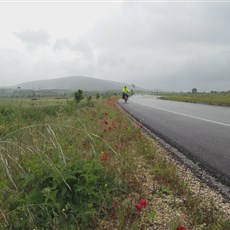
Between Karacabey and Bandirma
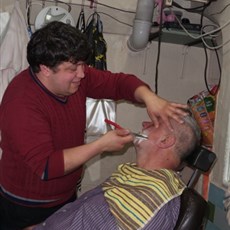
Bandirma - Charl's first shave since 1998
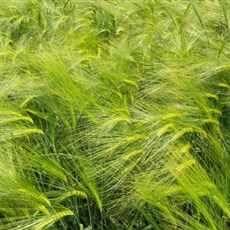
Between Biga and Lapseki
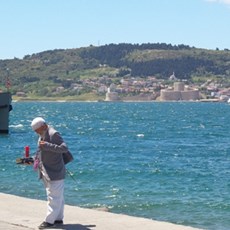
Çanakkale and the Dardanelles
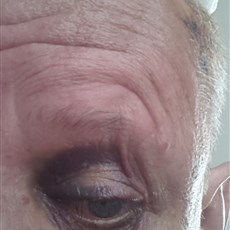
Charl's head injury and black eye
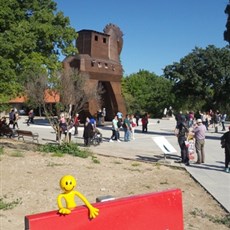
Bertie our travelling companion at Troy
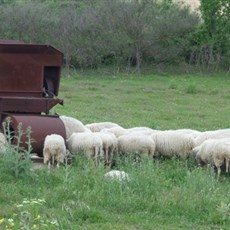
Between Levfikiye and Ayvacik
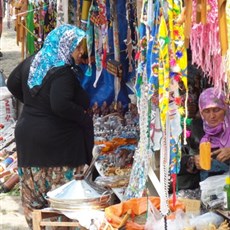
Behramkale
_thumb.jpg)
Behramkale
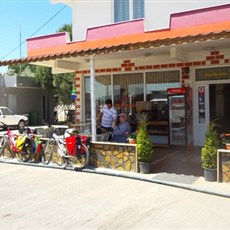
Between Edremit and Ayvalik
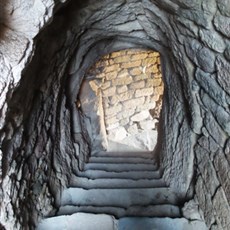
Pergamum theatre entrance
_thumb.jpg)
Pergamum
_thumb.jpg)
Sardis